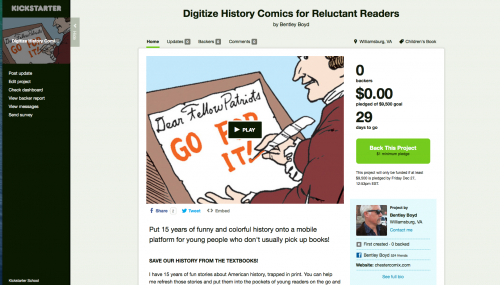

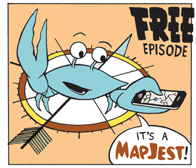

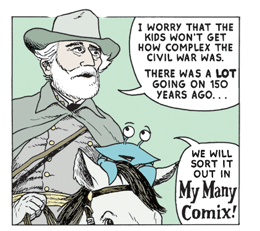

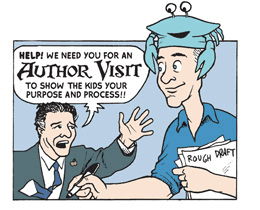

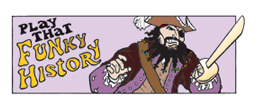

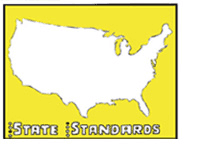


|
|

|
 |
||
 |
"The kids are so interested because of the comic book set, the creative illustrations, and the fantastic writing. It is very well put together and can apply to a broad range of ages." Melissa M. |
|
|
|
||
Archive for the ‘Author’s Purpose’ Category
The Long March is OVER
Written on Tuesday, April 8th, 2014 [permanent link]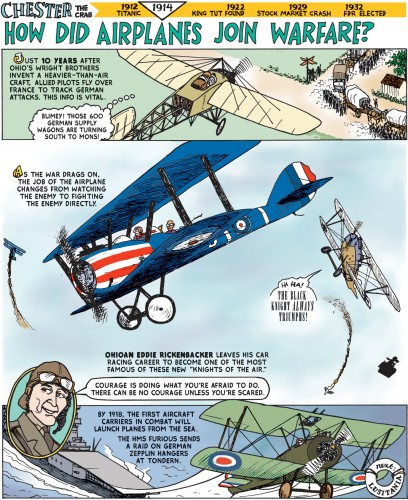
In the spring season of school talks, I often get asked how long it takes me to make a Chester comic. The answer varies widely because some of the books are just reprints of four stories I drew years ago for the Daily Press but others are created from scratch. The fastest I ever went from blank pages to a completed book was the George Washington biography I did for Mount Vernon: just a shade over four months from start to finish.
The worst I ever did was the book that just ended yesterday.
My World War 2 Tales book has sold well for many years. Boys still love to read about WW2 because it has cool technology and a simple moral structure — like Star Wars. But World War I remained the biggest gap in the timeline of my book subjects. Teachers and students struggle to understand that war because it was such a mess of obscure European politics and because the battles never really went anywhere. It was one big mudpit. But MY mission is to make such dense history into an understandable story (like I do in Constitution Construction, for example), so in the summer of 2009, I waded into the mud.
Yeah. You read that right. SUMMER OF 2009. I rough drafted the pages while sitting on picnic benches at a Boy Scout summer camp in North Carolina. The Scouts enjoyed seeing my progress from day to day and making suggestions of jokes and details to add. In the coming months I drew the pages in finished form, and by Labor Day of 2010 I had the children of friends coloring in the pages on my computer. All good! The heavy lifting was done!!! But the more we all nibbled at it, the farther the finish line seemed to pull away into the distance.
What happened? This book got sucked into the very sinkhole that I warn young artists about: a never-ending fussiness that swallows you up when you don’t have a stated deadline. For my whole career I’ve been able to punch out something decent in a defined time — the hallmark of newspaper cartooning — but this was a book driven by just me. And for once my drive sank into the complex details of the pages, and I got stuck. All I had to do was finish coloring this British uniform or that map or the German veteran in the last panel on the last page. But I couldn’t muster the care and attention to detail that it takes to finish art that is historically accurate.
There were plenty of excuses to point to. It was easier to indulge my curiosity elsewhere than to knuckle down on finishing the details of the WWI book. My creative hours got crunched when I began contract work at Historic Jamestowne in January 2011 so I could get paid while learning the latest historical discoveries for 17th century America (I’m still out on the island and having a good time — last weekend we married off Pocahontas on the 400th anniversary of her wedding!!). Then I got a contract to do a book about Oberlin, Ohio — my home state, and a town with a lot of cool 19th century history that I hadn’t drawn before. Then I got a contract to do a book about Lexington, Massachusetts. And then contracts to draw for Colonial Williamsburg. And when someone brings you a check to draw new stuff, you take the check.
That’s why “the cobbler’s children have no shoes.” Once I got distracted, it was hard to find a clear direction out of the WWI mud. This spring — goaded on by my son who was at that Scout camp in 2009 (who is now a HIGH SCHOOL JUNIOR) and by the oncoming 100th anniversary of the start of World War I (THIS AUGUST!!!) — I pushed through to finish the book. Every one of those Scouts and kids who helped me years ago is going to get a free copy of this comic.
If I can track down their college dorm room addresses . . .
Posted in Author's Purpose | Comments Off on The Long March is OVER
KICKSTARTER CRAB
Written on Wednesday, November 27th, 2013 [permanent link]And to finish off the 10th anniversary year of Chester Comix: A PLEA FOR MONEY!
No, see, this really does make sense. Chester Comix LLC launched in 2003 with generous financial help from many friends and family members. And a few credit cards. The business has continued to grow with important and timely support from many sources. Revenues have climbed steadily, but the capital expenses are big — when you have to spend $12,000 to reprint just four of your 31 titles, the search for $$$$ is ongoing.
So it’s been obvious for several years that MOBILE is the answer. Selling stories that don’t require me to print on paper and ship books in boxes is a good way to smooth out the revenue stream and expand Chester’s audience. And tablets and smartphones are where many of today’s reluctant readers are actually reading (texts, social media). In 2010 I got three Chester stories into iTunes to be read on Apple’s iPhones and iTouches. In 2011 I got eight of Chester’s books into iBooks for Apple’s iPads.
But that’s not enough. I have more than ONE HUNDRED stories in my printed comix that I could turn into fun stories on smartphones. For the past two years I’ve been drawing new panels for those stories to add MORE jokes and MORE fun details that the textbooks miss. But as I gleefully drew, the technical requirements to get these stories onto the iPhone got thornier and thornier. It became like Gatsby’s green light or Ahab’s whale — the goal that remained stubbornly out of reach the closer I got to it. An Apple rep told me last summer what it would take to build on the existing Chester story apps. His solution requires more intense programming. And that requires more money.
So: KICKSTARTER. Kickstarter is for artists what venture capitalists are to Silicon Valley. It’s crowdsourcing — a way for me to raise small amounts of money from fans far and wide and add them into a big project. I love that part of the Kickstarter model is that I give the supporters unique rewards. Check out the link to the project to see some of the fun (everything from free copies of the stories we make to signed copies of full Chester pages to a drawing of yourself in one of the stories!).
The other big part of the Kickstarter model is that the projects have a limited time to raise the funds. We have 30 days. LET’S GET IT!
Tags: comics, history, iPhone, Kickstarter
Posted in Author's Purpose | Comments Off on KICKSTARTER CRAB
Common Core is No Reason to Panic
Written on Tuesday, November 12th, 2013 [permanent link]I’ve been at this long enough that the new Common Core State Standards are the fourth round of standardized testing I’ve worked with.
And the fuss over them is familiar. Each round of testing has had its public outcry. But if you’ve followed educational testing since 1991 as I have, this new round is the next logical step from the previous three rounds. And these standards have some specific goals that I’ve endorsed for years.
What is the Common Core? It’s a push by the National Governors Association and the Council of Chief State School Officers to line up the tested standards that have been in place in most states since the late 1990s. When I started drawing Chester’s comix with content in 1999, I found a lot of similarity between those standards that the states set. The Common Core tries to put those similarities into plain terms — if everyone tests on the same science curriculum, then Vermont can know better how it stands in comparison to Texas or Virginia. The Common Core also logically follows the federal No Child Left Behind law from the 2000s: both of them focus on testing test math, science, and language arts, and both allow states to compete for federal money based on showing that test scores are improving year after year.
I see teachers scrambling to figure out what this new push means for their own individual classrooms. I think it’s more marketing than it is new machinery. The Common Core standards in my area seem to promote things that smart teachers are already doing and that I have been promoting for more than a decade. For example: No Child Left Behind did not test social studies, so I sold Chester Comix in that era as a way to use fun nonfiction to help kids with their literacy skills, which WERE tested. Reluctant readers could build literacy AND learn history content at the same time.
The Common Core standards seem to be asking teachers to do that same thing in language arts. For example,
CCSS.ELA-Literacy.RI.3.7 asks students to “Use information gained from illustrations (e.g., maps, photographs) and the words in a text to demonstrate understanding of the text (e.g., where, when, why, and how key events occur).” That’s the whole thrust of Chester Comix adventures and the lessons in the matching teachers guides on my website!
The trouble is that the Common Core standards don’t say exactly what facts students should know about history in fifth grade, the way Virginia’s own Standards of Learning say exactly what students should know in studying the first half of U.S. history. Virginia’s social studies curriculum is very specific; the Common Core is more generalized and is focused on SKILLS. The Common Core’s CCSS.ELA-Literacy.RI.5.4 says “Determine the meaning of general academic and domain-specific words and phrases in a text relevant to a grade 5 topic or subject area,” but it doesn’t give you what those words should be or the topic area or anything else. It’s up to the state or the district to say what subject area will be taught in Grade 5. So the history standards that South Dakota had in place before can still be taught under the Common Core.
I’m not sure exactly what this means for the Common Core test questions. The first Common Core tests are supposed to be given in the 2014-15 school year. The teachers who ask me now about how Chester Comix matches the Common Core get an answer that is either too long (like this blog) or too short (“ALL my comix teach the Common Core!”). Chester answers the Common Core in the structure of the whole enterprise. You can work on the Common Core skills by using the timelines across the top of each page. . . the headlines that are questions. . . the material in the teachers guides.
But if you’d like the longer answer, I’ve laid out some of the relevant Common Core standards and my thinking here.
Now let’s get back to teaching!!
Posted in Author's Purpose | Comments Off on Common Core is No Reason to Panic


